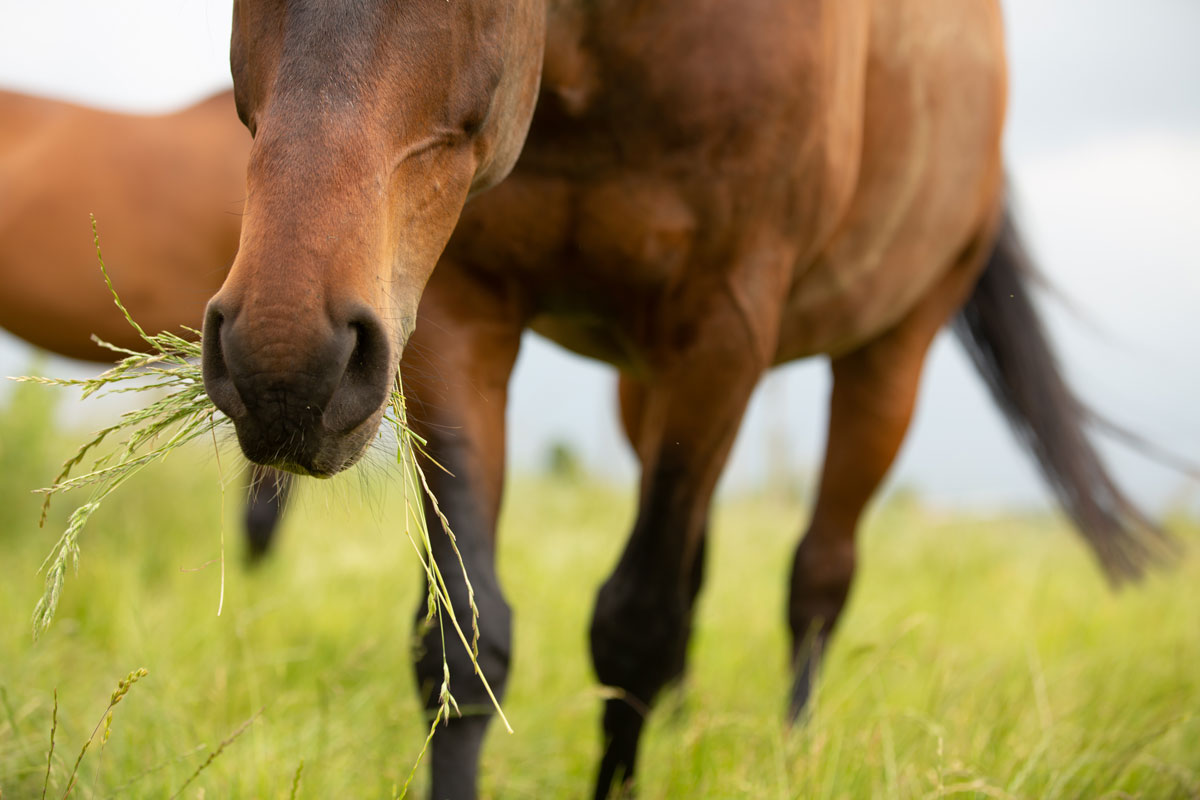In the past decade, research has increased our understanding of horse diseases, and especially of Equine Gastric Ulcer Syndrome, more commonly called ulcer in horses.
More recently, two distinct equine diseases affecting different areas of the stomach have been identified: equine squamous gastric disease (ESGD) and equine glandular gastric disease (EGGD). While we know the risk factors for ESGD, still not much is known about EGGD.
What are Gastric Ulcers?
Gastric ulcers are anerosion of the stomach lining due to prolonged exposure to gastric acid and are, by veterinarians, graded on a system ranging from 0 (absent) to 4 (extensive and deep).
According to recent estimates, about 40 percent of saddle horses, 60 percent of competition horses, and 90 percent of racehorses could be affected by ulcers.
What are the causes of gastric ulcer?
Low-fiber diets
Fiber takes longer to chew than concentrated feeds. This facilitates the creation of abundant saliva, which, in turn, helps buffer acidity in the stomach.
High grain diet
A study conducted in Denmark showed that offering more than 2 g per kg live weight of starch per day or 1 g per kg live weight per meal facilitates the development of an acidic environment in your Horse’s stomach.
A diet high in grains and, consequently, starch, thus creates a more acidic environment and raises the chances of incurring gastric ulcers.
Aerobic (fast speed) or intense work
Speed, understood as the horse’s physical speed, can push acid into certain areas of the stomach that are vulnerable to ulcer development. The presence of fiber in your Horse’s stomach becomes, therefore, essential because it acts as a barrier.
Stress
Horses and ponies that are left to graze 24/7 also suffer from ulcers, despite being perfectly fed.
In fact, one study showed that some horses in one group developed ulcers when certain components were removed from the group.
In short, just as it does for us humans, stress plays an important role in the development of gastric ulcers.

Symptoms of ulcers in horses
It is not always easy to distinguish the symptoms of ulcers from other horse diseases or disorders , but some include weight loss, dull coat, and intermittent colic. It is important to understand that even overweight and healthy horses can have ulcers. It is also clear that there is no link between the severity of ulcers and symptoms-some horses with grade 4 ulcers may show no outwardly visible signs of problems!
Feeding strategies that increase the risk of gastric ulcers in horses:
- Feeds for horses with ulcers may be deficient in fiber-chewing fiber produces more than twice the amount of saliva than chewing concentrates, helping to neutralize acidity in the horse’s stomach
- Administering 1% of body weight in grain resulted in a marked increase in ulcers in horses
- Administering 2g/kg body weight in BW starch daily or 1g/kg body weight per meal more than doubled the risk of gastric ulcers in horses

Food for horses with ulcers
Feeding horses with ulcers focuses on reducing risk factors to avoid this condition-follow these tips to keep your horse healthy :
- Feed plenty of forage to increase chewing time and thus saliva production, which will naturally regulate acidity levels in the stomach. Use low-calorie forages to provide chewing time without weight gain.
- Feed little and often-divide the total forage ration into as many small meals as possible to keep the stomach emptying time as short as possible.
- Avoid the use of grain-based concentrates, as these increase the risk of ulcers in horses. Use more digestible fiber sources such as alfalfa with added oil to meet energy requirements. Dengie Healthy Tummy provides 11.5MJ/kg of slow-release energy, which is the equivalent of an average energy mix. Performance Sports Chaff helps lengthen the chewing time of the feed and helps make individual concentrates part of the diet more voluminous. It also promotes chewing for maximum feed assimilation.
- Include alfalfa in the diet of horses with ulcers. Research has shown that alfalfa is a better acidity buffer than other fiber sources because of its protein and calcium content. Saracen’s Alfalfa Oil Chaff, Pure Meadow Chaff, High Fibre-Light Chaff and Alfalfa Chaff products and Dengie’s Healthy Hooves Molasses Free, Healthy Tummy, Alfa-A Molasses Free and Hi-Fi Molasses Free products are all alfalfa-based.
- Provide a small amount of fiber before riding so that he does not have an empty stomach when being ridden-a handful or two of chopped fiber is ideal.
- It may be necessary to reduce the intensity of exercise to allow ulcers to heal. For ulcers in the gastric region of the stomach, research has shown that 2 days of rest per week is beneficial.
- Try to avoid unnecessary stressful situations, which could greatly worsen the symptoms of ulcers in horses and many other equine conditions.

For horses with EGGD
A consensus statement on EGGD was published by specialists representing the European College of Equine Internal Medicine (ECEIM). In it, it states that there is no proven link between diet and EGGD, but it still recommends that the same feeding strategies for squamous gastric ulcers in horses (described above) be implemented. In addition, the following advice was given, which applies to this and almost all horse diseases :
- Provide a minimum of 2 days off per week from work, if possible, or provide regular rest periods
- Grazing where possible, provided the horse is not stressed. Some horses that are not used to grazing may be better off in a box environment
- Minimize management changes and other potential stressors
- Minimizing changes between equine companions
